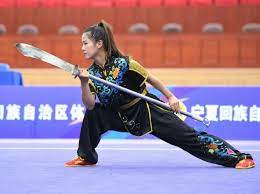
Gunshu (Staff Techniques)
Embracing the Ancient Art of Gunshu: Staff Techniques in Wushu
Welcome to the mesmerizing world of Gunshu, where the staff becomes an extension of the body and movement becomes poetry in motion. Gunshu, also known as staff techniques, is a traditional martial art that traces its roots back to ancient China, where it was developed as a practical combat system and later evolved into a graceful and dynamic form of artistic expression. In this comprehensive guide, we will delve into the origins, techniques, training methods, and cultural significance of Gunshu, as well as its enduring legacy in the world of martial arts.
Origins and Evolution
Gunshu has a rich and storied history that dates back thousands of years, originating from the battlefields and training grounds of ancient China. The staff, or gun, was one of the earliest and most versatile weapons employed by warriors and soldiers, prized for its simplicity, effectiveness, and versatility in combat.
Over time, Gunshu evolved from a practical martial art into a sophisticated form of artistic expression, with practitioners incorporating intricate forms, fluid movements, and intricate techniques into their repertoire. Gunshu routines became a staple of traditional Wushu practice, captivating audiences with their grace, precision, and athleticism.
Principles of Gunshu
Gunshu is guided by several fundamental principles that govern its techniques and applications:
1. Balance and Control:
Central to Gunshu is the principle of balance, wherein practitioners learn to wield the staff with precision and control while maintaining their own equilibrium. By mastering balance, practitioners can execute techniques with grace and fluidity, maximizing the effectiveness of their movements.
2. Fluidity and Flow:
Gunshu emphasizes fluidity and flow in movement, with practitioners seamlessly transitioning between techniques and forms. Movements are executed with grace and ease, creating a mesmerizing spectacle for audiences and spectators alike.
3. Precision and Timing:
Precision is paramount in Gunshu, as practitioners must execute techniques with accuracy and timing to achieve maximum impact. Techniques are performed with exacting precision, with practitioners aiming to strike targets with pinpoint accuracy and efficiency.
4. Strength and Power:
While Gunshu emphasizes grace and finesse, it also requires strength and power to execute techniques effectively. Practitioners develop strength in their wrists, arms, and core muscles, allowing them to wield the staff with speed and force.
Techniques of Gunshu
Gunshu encompasses a diverse array of techniques, each designed to showcase the versatility and effectiveness of the staff as a weapon. Some of the most common techniques include:
1. Strikes and Thrusts:
Gunshu techniques include a variety of strikes and thrusts, ranging from simple strikes to more complex combinations. Practitioners learn to wield the staff with precision, delivering powerful blows to their opponents while maintaining control and balance.
2. Blocks and Defenses:
Defensive techniques are an essential aspect of Gunshu, allowing practitioners to deflect and neutralize attacks from opponents. Blocks and defenses are executed with speed and precision, enabling practitioners to protect themselves while setting up counterattacks.
3. Spins and Flourishes:
Gunshu routines often feature spins and flourishes, where practitioners manipulate the staff with agility and dexterity. Spins and flourishes add flair and style to Gunshu performances, captivating audiences with their beauty and complexity.
4. Throws and Sweeps:
Advanced Gunshu techniques include throws and sweeps, where practitioners use the staff to off-balance and immobilize opponents. Throws and sweeps are executed with precision and timing, allowing practitioners to control their opponents while maintaining control of the staff.
Training Methods and Practice
Training in Gunshu is both rigorous and disciplined, requiring practitioners to develop strength, flexibility, agility, and technique. Training methods typically include:
1. Technical Drills:
Practitioners engage in drills to develop proficiency in fundamental Gunshu techniques, focusing on proper form, balance, and timing. Partner drills allow practitioners to practice applying techniques in a cooperative setting, refining their skills through repetition and feedback.
2. Forms Practice:
Gunshu routines, or forms, are a central component of training, allowing practitioners to showcase their skills and creativity. Practitioners memorize and perform a series of movements and techniques, incorporating strikes, blocks, spins, and flourishes into their routines.
3. Strength and Conditioning:
Physical conditioning is essential for Gunshu practitioners, as it helps develop the strength, endurance, and agility needed to execute techniques effectively. Training regimens may include strength training, cardiovascular exercises, flexibility drills, and functional movement exercises tailored to enhance martial arts performance.
4. Performance and Competition:
Gunshu competitions provide practitioners with the opportunity to showcase their skills and compete against opponents in a controlled, regulated environment. Competitors participate in various divisions and categories, with judges scoring performances based on criteria such as technique, fluidity, and presentation.
Cultural Significance of Gunshu
Gunshu holds a special place in Chinese culture, serving as a symbol of strength, discipline, and tradition. Throughout history, the staff has been revered as a symbol of martial prowess and spiritual enlightenment, with legendary warriors and martial artists mastering its techniques and principles.
Today, Gunshu continues to thrive as a celebrated martial art and cultural tradition, with practitioners around the world preserving its legacy and passing down its teachings to future generations. Gunshu performances are featured in festivals, ceremonies, and cultural events, where they serve as a testament to the enduring spirit of Wushu and its timeless principles of honor, discipline, and excellence.
Conclusion
Gunshu stands as a testament to the timeless beauty and power of traditional Wushu, offering practitioners a rich and rewarding journey of self-discovery and mastery. Through its emphasis on balance, precision, and flow, Gunshu empowers practitioners to unlock their full potential and express themselves through the artistry of the staff. Join us at the Amature Association of Wushu Hisar as we celebrate the ancient art of Gunshu, where every movement is a testament to the indomitable spirit of Wushu.